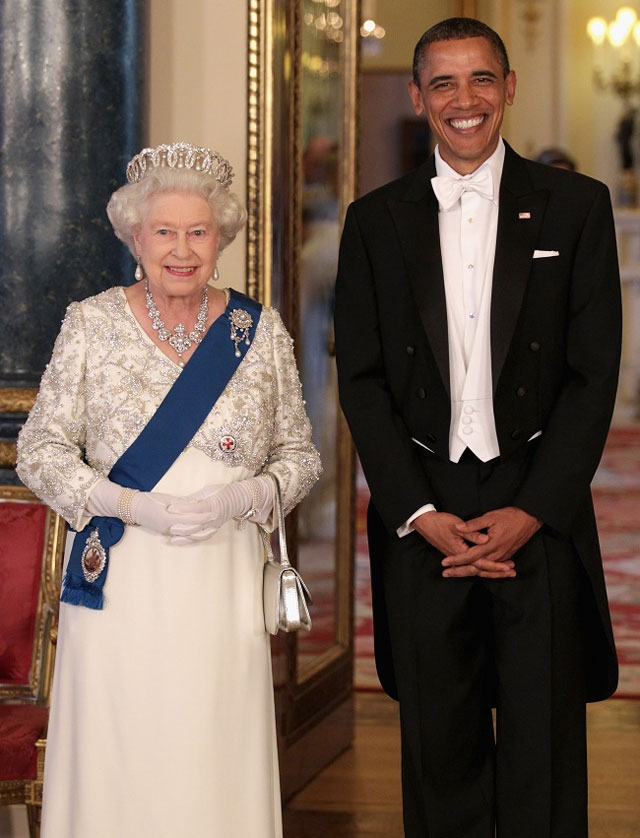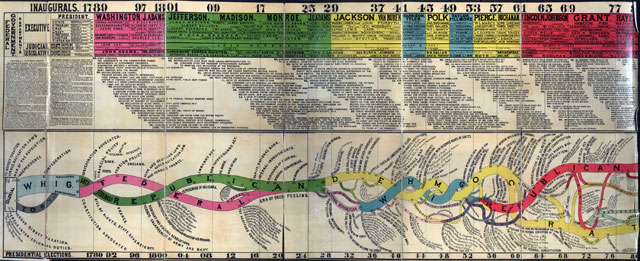kottke.org posts about USA

If this photo series from 1950 of the interior of the White House being ripped out so that the building could be structurally reinforced isn’t an apt metaphor for the current state of American politics, I don’t know what is.
Experts called the third floor of the White House “an outstanding example of a firetrap.” The result of a federally commissioned report found the mansion’s plumbing “makeshift and unsanitary,” while “the structural deterioration [was] in ‘appalling degree,’ and threatening complete collapse.” The congressional commission on the matter was considering the option of abandoning the structure altogether in favor of a built-from-scratch mansion, but President Truman lobbied for the restoration.
“It perhaps would be more economical from a purely financial standpoint to raze the building and to rebuild completely,” he testified to Congress in February 1949. “In doing so, however, there would be destroyed a building of tremendous historical significance in the growth of the nation.”
So it had to be gutted. Completely. Every piece of the interior, including the walls, had to be removed and put in storage. The outside of the structure-reinforced by new concrete columns-was all that remained.
(via digg)
This Justice Department memo about when the US government, without hearing or trial or due process or whatever other “rights” we as a country hold dear, can kill US citizens is fucking bullshit.
A confidential Justice Department memo concludes that the U.S. government can order the killing of American citizens if they are believed to be “senior operational leaders” of al-Qaida or “an associated force” — even if there is no intelligence indicating they are engaged in an active plot to attack the U.S.
The 16-page memo, a copy of which was obtained by NBC News, provides new details about the legal reasoning behind one of the Obama administration’s most secretive and controversial polices: its dramatically increased use of drone strikes against al-Qaida suspects abroad, including those aimed at American citizens, such as the September 2011 strike in Yemen that killed alleged al-Qaida operatives Anwar al-Awlaki and Samir Khan. Both were U.S. citizens who had never been indicted by the U.S. government nor charged with any crimes.
The whole memo is here. A staggering disappointment from a man many think is better than this. See also: Obama’s lethal Presidency.
According to Google’s search tracking, this is the worst flu season in more than 6 years.

Google’s trends tend to follow the official CDC data closely and indeed the CDC concurs about the scope of the flu this year but their data is lagging behind Google’s by what looks like about 2 weeks. See also my post on how flu vaccines are made. (via @kellan)
During her reign, Queen Elizabeth II of England has met 10 sitting US Presidents, every one from Eisenhower to Obama except for Lyndon Johnson. She also met Harry Truman as a princess in 1951 and former President Herbert Hoover in 1957.



You can see the entire progression here or here. QEII is more definitely a human wormhole.
BTW, Elizabeth is creeping up on Queen Victoria as the longest-reigning British monarch, just another two-and-a-half years to catch her. Victoria reigned during the terms of 19 different Presidents but never met any of them and had an unfair advantage…lots of short terms and one-term Presidencies back then. (via mlkshk)
From Stone, the NY Times’ blog of philosophers writing about current events, a post by Firmin DeBrabander about what sort of society (polite? uncivil? safe?) an armed society is.
Arendt offers two points that are salient to our thinking about guns: for one, they insert a hierarchy of some kind, but fundamental nonetheless, and thereby undermine equality. But furthermore, guns pose a monumental challenge to freedom, and particular, the liberty that is the hallmark of any democracy worthy of the name — that is, freedom of speech. Guns do communicate, after all, but in a way that is contrary to free speech aspirations: for, guns chasten speech.
This becomes clear if only you pry a little more deeply into the N.R.A.’s logic behind an armed society. An armed society is polite, by their thinking, precisely because guns would compel everyone to tamp down eccentric behavior, and refrain from actions that might seem threatening. The suggestion is that guns liberally interspersed throughout society would cause us all to walk gingerly — not make any sudden, unexpected moves — and watch what we say, how we act, whom we might offend.
(via @TomJunod)
Jon Lee Anderson asks, in reference to mass shootings, “What does it take for a society to be sickened by its own behavior and to change its attitudes?”
When will we Americans realize that our society is an unacceptably violent one, that this is how the rest of the world sees us, and that much of that violence is associated with guns? Will it be the massacre at Sandy Hook Elementary School? Where is our threshold for self-awareness?
When God said in the Bible “you shall have no other gods before me”, one of the gods he was referring to was Moloch, an Ammonite god worshipped by the Phoenicians and Canaanites who was associated with the sacrifice of children by his followers. In a short essay for The New York Review of Books, Gary Wills singles out the gun as America’s Moloch.
Read again those lines, with recent images seared into our brains-“besmeared with blood” and “parents’ tears.” They give the real meaning of what happened at Sandy Hook Elementary School Friday morning. That horror cannot be blamed just on one unhinged person. It was the sacrifice we as a culture made, and continually make, to our demonic god. We guarantee that crazed man after crazed man will have a flood of killing power readily supplied him. We have to make that offering, out of devotion to our Moloch, our god. The gun is our Moloch. We sacrifice children to him daily-sometimes, as at Sandy Hook, by directly throwing them into the fire-hose of bullets from our protected private killing machines, sometimes by blighting our children’s lives by the death of a parent, a schoolmate, a teacher, a protector. Sometimes this is done by mass killings (eight this year), sometimes by private offerings to the god (thousands this year).
The gun is not a mere tool, a bit of technology, a political issue, a point of debate. It is an object of reverence. Devotion to it precludes interruption with the sacrifices it entails. Like most gods, it does what it will, and cannot be questioned. Its acolytes think it is capable only of good things. It guarantees life and safety and freedom. It even guarantees law. Law grows from it. Then how can law question it?
From Pro Publica back in July, the best reporting on guns in America.
In the wake of last week’s shooting in Aurora, Colo., we’ve taken a step back and laid out the best pieces we could find about guns. They’re roughly organized by articles on rights, trafficking and regulation.
More facts about guns in America from Ezra Klein, beginning with the sad fact that “shooting sprees are not rare in the United States”.
If roads were collapsing all across the United States, killing dozens of drivers, we would surely see that as a moment to talk about what we could do to keep roads from collapsing. If terrorists were detonating bombs in port after port, you can be sure Congress would be working to upgrade the nation’s security measures. If a plague was ripping through communities, public-health officials would be working feverishly to contain it.
Only with gun violence do we respond to repeated tragedies by saying that mourning is acceptable but discussing how to prevent more tragedies is not. But that’s unacceptable. As others have observed, talking about how to stop mass shootings in the aftermath of a string of mass shootings isn’t “too soon.” It’s much too late.
From the New Yorker back in April, Jill Lepore wrote about the history of guns in America.
There are nearly three hundred million privately owned firearms in the United States: a hundred and six million handguns, a hundred and five million rifles, and eighty-three million shotguns. That works out to about one gun for every American. The gun that T. J. Lane brought to Chardon High School belonged to his uncle, who had bought it in 2010, at a gun shop. Both of Lane’s parents had been arrested on charges of domestic violence over the years. Lane found the gun in his grandfather’s barn.
The United States is the country with the highest rate of civilian gun ownership in the world. (The second highest is Yemen, where the rate is nevertheless only half that of the U.S.) No civilian population is more powerfully armed. Most Americans do not, however, own guns, because three-quarters of people with guns own two or more. According to the General Social Survey, conducted by the National Policy Opinion Center at the University of Chicago, the prevalence of gun ownership has declined steadily in the past few decades. In 1973, there were guns in roughly one in two households in the United States; in 2010, one in three. In 1980, nearly one in three Americans owned a gun; in 2010, that figure had dropped to one in five.
Earlier this morning in a post about Apple manufacturing their products in the US, I wrote “look for this “made in the USA” thing to turn into a trend”. Well, Made in the USA is already emerging as a trend in the media. On Tuesday, Farhad Manjoo wrote about American Giant, a company who makes the world’s best hoodie entirely in the US for a decent price.
For one thing, Winthrop had figured out a way to do what most people in the apparel industry consider impossible: He’s making clothes entirely in the United States, and he’s doing so at costs that aren’t prohibitive. American Apparel does something similar, of course, but not especially profitably, and its clothes are very low quality. Winthrop, on the other hand, has found a way to make apparel that harks back to the industry’s heyday, when clothes used to be made to last. “I grew up with a sweatshirt that my father had given me from the U.S. Navy back in the ’50s, and it’s still in my closet,” he told me. “It was this fantastic, classic American-made garment — it looks better today than it did 35, 40 years ago, because like an old pair of denim, it has taken on a very personal quality over the years.”
The Atlantic has a pair of articles in their December issue, Charles Fishman’s The Insourcing Boom:
Yet this year, something curious and hopeful has begun to happen, something that cannot be explained merely by the ebbing of the Great Recession, and with it the cyclical return of recently laid-off workers. On February 10, [General Electric’s Appliance Park in Louisville, KY] opened an all-new assembly line in Building 2 — largely dormant for 14 years — to make cutting-edge, low-energy water heaters. It was the first new assembly line at Appliance Park in 55 years — and the water heaters it began making had previously been made for GE in a Chinese contract factory.
On March 20, just 39 days later, Appliance Park opened a second new assembly line, this one in Building 5, to make new high-tech French-door refrigerators. The top-end model can sense the size of the container you place beneath its purified-water spigot, and shuts the spigot off automatically when the container is full. These refrigerators are the latest versions of a style that for years has been made in Mexico.
Another assembly line is under construction in Building 3, to make a new stainless-steel dishwasher starting in early 2013. Building 1 is getting an assembly line to make the trendy front-loading washers and matching dryers Americans are enamored of; GE has never before made those in the United States. And Appliance Park already has new plastics-manufacturing facilities to make parts for these appliances, including simple items like the plastic-coated wire racks that go in the dishwashers.
and James Fallows’ Mr. China Comes to America:
What I saw at these Chinese sites was surprisingly different from what I’d seen on previous factory tours, reflecting the political, economic, technological, and especially social pressures that are roiling China now. In conjunction with significant changes in the American business and technological landscape that I recently saw in San Francisco, these changes portend better possibilities for American manufacturers and American job growth than at any other time since Rust Belt desolation and the hollowing-out of the American working class came to seem the grim inevitabilities of the globalized industrial age.
For the first time in memory, I’ve heard “product people” sound optimistic about hardware projects they want to launch and facilities they want to build not just in Asia but also in the United States. When I visited factories in the upper Midwest for magazine stories in the early 1980s, “manufacturing in America” was already becoming synonymous with “Rust Belt” and “sunset industry.” Ambitious, well-educated people who had a choice were already headed for cleaner, faster-growing possibilities — in consulting, finance, software, biotech, anything but things. At the start of the ’80s, about one American worker in five had a job in the manufacturing sector. Now it’s about one in 10.
Add to that all of the activity on Etsy and the many manufactured-goods projects on Kickstarter that are going “Made in the USA” (like Flint & Tinder underwear (buy now!)) and yeah, this is definitely a thing.
As noted by Fishman in his piece, one of the reasons US manufacturing is competitive again is the low price of natural gas. From a piece in SupplyChainDigest in October:
Several industries, noticeable chemicals and fertilizers, use lots of natural gas. Fracking and other unconventional techniques have already unlocked huge supplies of natural gas, which is why natural gas prices in the US are at historic lows and much lower than the rest of the world.
Right now, nat gas prices are under $3.00 per thousand cubic, down dramatically from about three times that in 2008 and even higher in 2006. Meanwhile, natural gas prices are about $10.00 right now in Europe and $15.00 in parts of Asia.
Much of the growing natural gas reserves come from the Marcellus shale formation that runs through Western New York and Pennsylvania, Southeast Ohio, and most of West Virginia. North Dakota in the upper Midwest also is developing into a major supplier of both oil and natural gas.
So basically, energy in the US is cheap right now and will likely remain cheap for years to come because hydraulic fracturing (aka fracking aka that thing that people say makes their water taste bad, among other issues) has unlocked vast and previously unavailable reserves of oil and natural gas that will take years to fully exploit. A recent report by the International Energy Agency suggests that the US is on track to become the world’s biggest oil producer by 2020 (passing both Saudi Arabia and Russia) and could be “all but self-sufficient” in energy by 2030.
By about 2020, the United States will overtake Saudi Arabia as the world’s largest oil producer and put North America as a whole on track to become a net exporter of oil as soon as 2030, according to a report from the International Energy Agency.
The change would dramatically alter the face of global oil markets, placing the U.S., which currently imports about 45 percent of the oil it uses and about 20 percent of its total energy needs, in a position of unexpected power. The nation likely will become “all but self-sufficient” in energy by 2030, representing “a dramatic reversal of the trend seen in most other energy-importing countries,” the IEA survey says.
So yay for “Made in the USA” but all this cheap energy could wreak havoc on the environment, hinder development of greener alternatives to fossil fuels (the only way green will win is to compete on price), and “artificially” prop up a US economy that otherwise might be stagnating. (thx, @rfburton, @JordanRVance, @technorav)
According to CEO Tim Cook, Apple will start making some of its computers entirely in the US.
Apple CEO Tim Cook announced one of the existing Mac lines will be manufactured exclusively in the United States next year. Mac fans will have to wait to see which Mac line it will be because Apple, widely known for its secrecy, left it vague. Cook’s announcement may or may not confirm recent rumors in the blogosphere sparked by iMacs inscribed in the back with “Assembled in USA.”
Well, those iMac pretty clearly state they are assembled in the US. And look for this “made in the USA” thing to turn into a trend…I think companies are finding that making stuff in the US is not as expensive as everyone thinks it is.
Update: BusinessWeek has a long interview with Cook about US manufacturing, among many other topics.
It’s not known well that the engine for the iPhone and iPad is made in the U.S., and many of these are also exported-the engine, the processor. The glass is made in Kentucky. And next year we are going to bring some production to the U.S. on the Mac. We’ve been working on this for a long time, and we were getting closer to it. It will happen in 2013. We’re really proud of it. We could have quickly maybe done just assembly, but it’s broader because we wanted to do something more substantial. So we’ll literally invest over $100 million. This doesn’t mean that Apple will do it ourselves, but we’ll be working with people, and we’ll be investing our money.
To answer the question, “If every state of the USA declared war against each other, which would win?” Quora user Jon Davis went way in-depth writing “the accounts of the Second American Civil War, also known as the Wars of Reunification and the American Warring States Period.” It’s sort of a mix between World War Z (oral histories) and the post on Reddit being turned into a movie (realistic seeming discussion of military action). I am a sucker for this kind of fictionalized future-history stuff.
First came a period of massive migration back to the homelands. Facing the newly invented discrimination that will be created many felt the need to go back to their own people. While the individual states retained all military assets they couldn’t control the individuals who fight. A Texas Marine stationed in California, would not fight for California. A soldier in New York would not fight against their home in Virginia and a sailor in Houston would not fight against their home state of Florida. The warriors returned to their home states and the states had to re-consider that when they measured troop strength of their new nations. Ultimately, they measured troop strength by how much of the population would return home.
(via Stellar)

Of the current 200 nations in the world, the British have invaded all but 22 of them. The lucky 22 include Sweden, Luxembourg, Mongolia, Bolivia, and Belarus. The full analysis is available in Stuart Laycock’s book, All the Countries We’ve Ever Invaded.
Stuart Laycock, the author, has worked his way around the globe, through each country alphabetically, researching its history to establish whether, at any point, they have experienced an incursion by Britain.
Only a comparatively small proportion of the total in Mr Laycock’s list of invaded states actually formed an official part of the empire.
The remainder have been included because the British were found to have achieved some sort of military presence in the territory — however transitory — either through force, the threat of force, negotiation or payment.
Incursions by British pirates, privateers or armed explorers have also been included, provided they were operating with the approval of their government.
The US currently has military personnel stationed in all but 43 countries.
For instance, as of Sept. 30, 2011, there were 53,766 military personnel in Germany, 39,222 in Japan, 10,801 in Italy and 9,382 in the United Kingdom. That makes sense. But wait, scanning the list, you also see nine troops in Mali, eight in Barbados, seven in Laos, six in Lithuania, five in Lebanon, four in Moldova, three in Mongolia, two in Suriname and one in Gabon.
But the presence in most of those countries is due to diplomatic usage of military personnel. (thx, aaron)
The Dust Bowl is a four-hour documentary by Ken Burns airing on PBS starting this weekend.
The Dust Bowl chronicles the worst man-made ecological disaster in American history, in which the frenzied wheat boom of the “Great Plow-Up,” followed by a decade-long drought during the 1930s nearly swept away the breadbasket of the nation. Vivid interviews with twenty-six survivors of those hard times, combined with dramatic photographs and seldom seen movie footage, bring to life stories of incredible human suffering and equally incredible human perseverance. It is also a morality tale about our relationship to the land that sustains us — a lesson we ignore at our peril.
You can watch the first five minutes of the film on the PBS site.
It was not my intent to be so politically oriented this morning but here we are. This is a chart that tracks the ideologies of the Democratic and Republican members of Congress from 1789 to 2010. As you can see, the shift away from the center by the Republicans since 1975 is unprecedented, perhaps matched only by the shift toward the center by the Democrats beginning in 1921 and ending in 1945.

This reminds me of a timeline created circa 1880 for a book called Conspectus of the History of Political Parties and the Federal Government:

Bigger version here. (via @joecarryon)
Today marks the 50th anniversary of the beginning of the Cuban Missile Crisis. In commemoration of the event, the JFK Presidential Library & Museum presents Clouds Over Cuba, a tense and engaging presentation on the Crisis and, even more strikingly, a dramatization on what might have happened had things gone differently. This is really well done and worth taking 10-15 minutes to watch/listen. (via @alexismadrigal)
A group of citizens is attempting to change Columbus Day to Exploration Day. Columbus Day has always been a weird holiday, what with CC’s slavery and genocide and all, so this seems like a good idea to me. Maggie Koerth-Baker makes the case over at Boing Boing.
The logic is quite neat. Columbus Day is about one guy and the (actually untrue) claim that he was the first person to discover America. Inherently, that’s pretty Euro-centric, which is a big part of why it sits awkwardly in a pluralistic country. But exploration is inclusive. The ancestors of Native Hawaiians were explorers who crossed the ocean. The ancestors of Native Americans explored their way across the Bering land bridge and then explored two whole continents. If you look at the history of America, you can see a history of exploration done by many different people, from many different backgrounds. Sometimes we’re talking about literal, physical exploration. Other times, the exploring is done in a lab. Or in space. But the point is clear: This country was built on explorers. And it needs explorers for the future.
If you want to help out, sign this petition to Congress or this one to the White House.
Starting with a blank map of the US, the object is to place each state in its proper place.

My average error was 8 miles. A better test would be to start each state with the blank map…placing Colorado in the western part of the country without any guide is much tougher than doing it last. (via @notrobwalker)
In the New Yorker, Elizabeth Kolbert says that, “with the exception of the imperial offspring of the Ming dynasty and the dauphins of pre-Revolutionary France”, American kids might be the most spoiled kids in the history of the world. Strong words but not without merit.
How did parents in different cultures train young people to assume adult responsibilities? In the case of the Angelenos, they mostly didn’t. In the L.A. families observed, no child routinely performed household chores without being instructed to. Often, the kids had to be begged to attempt the simplest tasks; often, they still refused. In one fairly typical encounter, a father asked his eight-year-old son five times to please go take a bath or a shower. After the fifth plea went unheeded, the father picked the boy up and carried him into the bathroom. A few minutes later, the kid, still unwashed, wandered into another room to play a video game.
In another representative encounter, an eight-year-old girl sat down at the dining table. Finding that no silverware had been laid out for her, she demanded, “How am I supposed to eat?” Although the girl clearly knew where the silverware was kept, her father got up to get it for her.
In a third episode captured on tape, a boy named Ben was supposed to leave the house with his parents. But he couldn’t get his feet into his sneakers, because the laces were tied. He handed one of the shoes to his father: “Untie it!” His father suggested that he ask nicely.
“Can you untie it?” Ben replied. After more back-and-forth, his father untied Ben’s sneakers. Ben put them on, then asked his father to retie them. “You tie your shoes and let’s go,” his father finally exploded. Ben was unfazed. “I’m just asking,” he said.
From Quora, some interesting answers to the question “What facts about the United States do foreigners not believe until they come to America?” The economics of food was a popular response:
Fruit and vegetable prices, compared to fast food prices:
A bag of grapes: $6
A box of strawberries: $7
1lb tomatoes: $3
McChicken: $1
Big Mac : $1 ( I think. I don’t go to McDonalds though)
HOW DOES THAT EVEN WORK?
At the same time, there are things that you wouldn’t associate with first-world countries:
Religious fanaticism
It is hard to believe that a first-world country has non-progressive ideologies, especially that hurt women (the vaginal probes and other abortion related woes). Not only that, the belief in Earth’s age, talking snake etc. Being from India, it is even harder for me to understand this. I expected US to be more progressive. It is not as crazy as back in India but still something that I think is enough to be detrimental to the progress.
Others are pleasantly surprised:
Many Indians are very surprised to find out that there are large numbers of Americans who actually love their parents and siblings and wives and children and have normal, healthy relationships with them. Our media has them convinced that all Americans are very self-centered people who throw their kids out of their homes after high school, don’t care for their parents, and divorce their spouses. And, I swear, it is literally true that many Indians do not believe that this is not true until they have been to the US and seen examples of good healthy family relationships themselves. I have had heated arguments with people who’ve never been to the US, but can give lectures on how screwed up family values in the US are.
But we could also use some improvement:
There actually is an accepted piece of clothing called a ‘wife-beater’.
(via @alexandrak)
Max Fisher has a piece at The Atlantic about what travel guidebooks tell foreign visitors to the US.
Politics get heavy treatment in the books, as do the subtleties of discussing them, maybe more so than in any other guidebook I’ve read (what can I say, it’s an addiction). Lonely Planet urges caution when discussing immigration. “This is the issue that makes Americans edgy, especially when it gets politicized,” they write, subtly suggesting that some Americans might approach the issue differently than others. “Age has a lot to do with Americans’ multicultural tolerance.”
Rough Guide doesn’t shy away from the fact that many non-Americans are less-than-crazy about U.S. politics and foreign policy, and encouragingly notes that many Americans are just as “infuriated” about it as visitors might be. Still, it warns that the political culture saturates everything, and that “The combination of shoot-from-the-hip mentality with laissez-faire capitalism and religious fervor can make the U.S. maddening at times, even to its own residents.”
Having recently published a book about Paris, France, Rosecrans Baldwin visited a number of towns named Paris around the US to see how Americans perceive the French here in 2012. Here’s part one of his report.
The survey has eight questions ranging from general opinions to particular trivia. For example, “Whose side was France on during the American Revolutionary War?”
Sixty-six percent of respondents get it right: our side. Twenty percent are wrong. Incorrect answers include “the British,” “England,” “the opposite side,” and, oddly, “the French.” Other responses: “History was not my class in school — I hate it,” and “I am averse.” My favorite comes from a gas station attendant in Lexington, Ky., who writes: “I refuse to answer the rest of this survey. I love the French language. I have had many French friends.”
One guy in a parking lot outside a Dallas strip club says, “This has got to be a trick question.” And there’s another person, at Phoenix Sky Harbor International Airport, who will ask me, “You mean our American Revolutionary War?” Which appears to be a general concern — of the 55 people, at least 10 ask me to which American Revolution I am referring. Two people say, “But we didn’t have a revolution.”
The Morning News is serializing the other parts of this story all this month but you can get the whole thing right now on the Kindle.
Lakhdar Boumediene was imprisoned in the Guantanamo Bay detention camp for seven years on no charge and with no trial.
On Wednesday, America’s detention camp at Guantanamo Bay will have been open for 10 years. For seven of them, I was held there without explanation or charge. During that time my daughters grew up without me. They were toddlers when I was imprisoned, and were never allowed to visit or speak to me by phone. Most of their letters were returned as “undeliverable,” and the few that I received were so thoroughly and thoughtlessly censored that their messages of love and support were lost.
This is deeply deeply shameful.
In a piece for Vanity Fair, Kurt Andersen argues that for the first time in recent history, American pop culture (fashion, art, music, design, entertainment) hasn’t changed dramatically in the past 20 years.
Since 1992, as the technological miracles and wonders have propagated and the political economy has transformed, the world has become radically and profoundly new. (And then there’s the miraculous drop in violent crime in the United States, by half.) Here is what’s odd: during these same 20 years, the appearance of the world (computers, TVs, telephones, and music players aside) has changed hardly at all, less than it did during any 20-year period for at least a century. The past is a foreign country, but the recent past — the 00s, the 90s, even a lot of the 80s — looks almost identical to the present. This is the First Great Paradox of Contemporary Cultural History.
Think about it. Picture it. Rewind any other 20-year chunk of 20th-century time. There’s no chance you would mistake a photograph or movie of Americans or an American city from 1972-giant sideburns, collars, and bell-bottoms, leisure suits and cigarettes, AMC Javelins and Matadors and Gremlins alongside Dodge Demons, Swingers, Plymouth Dusters, and Scamps-with images from 1992. Time-travel back another 20 years, before rock ‘n’ roll and the Pill and Vietnam, when both sexes wore hats and cars were big and bulbous with late-moderne fenders and fins-again, unmistakably different, 1952 from 1972. You can keep doing it and see that the characteristic surfaces and sounds of each historical moment are absolutely distinct from those of 20 years earlier or later: the clothes, the hair, the cars, the advertising — all of it. It’s even true of the 19th century: practically no respectable American man wore a beard before the 1850s, for instance, but beards were almost obligatory in the 1870s, and then disappeared again by 1900. The modern sensibility has been defined by brief stylistic shelf lives, our minds trained to register the recent past as old-fashioned.

This map of the US was made by David Imus — he worked seven days a week for two years on it — and it won the Best of Show award at the Cartography and Geographic Information Society competition for 2010. Here’s why.
According to independent cartographers I spoke with, the big mapmaking corporations of the world employ type-positioning software, placing their map labels (names of cities, rivers, etc.) according to an algorithm. For example, preferred placement for city labels is generally to the upper right of the dot that indicates location. But if this spot is already occupied — by the label for a river, say, or by a state boundary line — the city label might be shifted over a few millimeters. Sometimes a town might get deleted entirely in favor of a highway shield or a time zone marker. The result is a rough draft of label placement, still in need of human refinement. Post-computer editing decisions are frequently outsourced-sometimes to India, where teams of cheap workers will hunt for obvious errors and messy label overlaps. The overall goal is often a quick and dirty turnaround, with cost and speed trumping excellence and elegance.
By contrast, David Imus worked alone on his map seven days a week for two full years. Nearly 6,000 hours in total. It would be prohibitively expensive just to outsource that much work. But Imus — a 35-year veteran of cartography who’s designed every kind of map for every kind of client — did it all by himself. He used a computer (not a pencil and paper), but absolutely nothing was left to computer-assisted happenstance. Imus spent eons tweaking label positions. Slaving over font types, kerning, letter thicknesses. Scrutinizing levels of blackness. It’s the kind of personal cartographic touch you might only find these days on the hand-illustrated ski-trail maps available at posh mountain resorts.
Update: The map is now in its fourth version of the second edition, updated in Sept 2022. I updated the image above to a snippet of the newest map.
Fuck Yeah Made in USA is a collection of videos showcasing products that are made in the US. These are chock full of “how things are made” goodness.
From Lapham’s Quarterly, Christopher Hitchens on capital punishment in America.
Since then no country has been allowed to apply for membership or association with the European Union without, as a precondition, dismantling its apparatus of execution. This has led states like Turkey to forego what was once a sort of national staple. The United Nations condemns capital punishment-especially for those who have not yet reached adulthood-and the Vatican has come close to forbidding if not actually anathematizing the business. This leaves the United States of America as the only nation in what one might call the West, that does not just continue with the infliction of the death penalty but has in the recent past expanded its reach. More American states have restored it in theory and carried it out in practice, and the last time the Supreme Court heard argument on the question it was to determine whether capital punishment should be inflicted for a crime other than first-degree murder (the rape of a child being the suggested pretext for extension).
Hitchens, as you may have guessed, pins much of the blame on religion…after all, the US is the most (or only?) fundamentalist country in the West. (via ★interesting-links)
For this coming weekend’s NY Times Magazine, journalist Jose Antonio Vargas shares the story of his Life as an Undocumented Immigrant.
One day when I was 16, I rode my bike to the nearby D.M.V. office to get my driver’s permit. Some of my friends already had their licenses, so I figured it was time. But when I handed the clerk my green card as proof of U.S. residency, she flipped it around, examining it. “This is fake,” she whispered. “Don’t come back here again.”
Vargas won a Pulitzer and wrote this article about Mark Zuckerberg for the New Yorker. I hope he can work out a way to stay in the United States…we need more people like him on our team.
The US military is often thought of by many Americans as being identified with conservative politics, making it an unlikely blueprint for progressive reform. But a recent pair of articles demonstrates that the US as a whole might have something to learn about the US Armed Forces’ liberal leanings. In the NY Times, Nicholas Kristof argues that the US military’s universal healthcare and focus on education is worth looking at as a model:
The military is innately hierarchical, yet it nurtures a camaraderie in part because the military looks after its employees. This is a rare enclave of single-payer universal health care, and it continues with a veterans’ health care system that has much lower costs than the American system as a whole.
Perhaps the most impressive achievement of the American military isn’t its aircraft carriers, stunning as they are. Rather, it’s the military day care system for working parents.
While one of America’s greatest failings is underinvestment in early childhood education (which seems to be one of the best ways to break cycles of poverty from replicating), the military manages to provide superb child care. The cost depends on family income and starts at $44 per week.
And the WSJ recently covered remarks made by Sgt. Maj. Micheal Barrett, the top non-commissioned officer in the Marine Corps and general all-around hardass, about gays in the military:
Article 1, Section 8 of the Constitution is pretty simple, It says, ‘Raise an army.’ It says absolutely nothing about race, color, creed, sexual orientation. You all joined for a reason: to serve. To protect our nation, right? How dare we, then, exclude a group of people who want to do the same thing you do right now, something that is honorable and noble? … Get over it. We’re magnificent, we’re going to continue to be. … Let’s just move on, treat everybody with firmness, fairness, dignity, compassion and respect. Let’s be Marines.
Now that’s some semper fi I can get behind. (thx, meg)
Newer posts
Older posts















Stay Connected